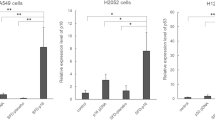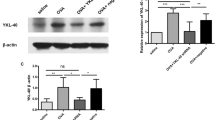Abstract
Lung cancer has emerged as a leading cause of cancer death in the world; however, most of the current conventional therapies are not sufficiently effective in altering the progression of disease. Therefore, development of novel treatment approaches is needed. Although several genes and methods have been used for cancer gene therapy, a number of problems such as specificity, efficacy and toxicity reduce their application. This has led to re-emergence of aerosol gene delivery as a noninvasive method for lung cancer treatment. In this study, nano-sized glucosylated polyethyleneimine (GPEI) was used as a gene delivery carrier to investigate the effects of Akt wild type (WT) and kinase deficient (KD) on Akt-related signaling pathways and protein translation in the lungs of CMV- LucR-cMyc-IRES-LucF dual reporter mice. These mice are a powerful tool for the discrimination between cap-dependent/-independent protein translation. Aerosols containing self-assembled nano-sized GPEI/Akt WT or GPEI/Akt KD were delivered into the lungs of reporter mice through nose-only-inhalation-chamber with the aid of nebulizer. Aerosol delivery of Akt WT caused the increase of protein expression levels of Akt-related signals, whereas aerosol delivery of Akt KD did not. Furthermore, dual luciferase activity assay showed that aerosol delivery of Akt WT enhanced cap-dependent protein translation, whereas a reduction in cap-dependent protein translation by Akt KD was observed. Our results clearly showed that targeting Akt may be a good strategy for prevention as well as treatment of lung cancer. These studies suggest that our aerosol delivery is compatible for in vivo gene delivery which could be used as a noninvasive gene therapy in the future.
This is a preview of subscription content, access via your institution
Access options
Subscribe to this journal
Receive 12 print issues and online access
$259.00 per year
only $21.58 per issue
Buy this article
- Purchase on Springer Link
- Instant access to full article PDF
Prices may be subject to local taxes which are calculated during checkout




Similar content being viewed by others
References
Dailey LA, Kleemann E, Merdana T, Petersena H, Schmehlb T, Gesslerb T et al. Modified polyethylenimines as non viral gene delivery systems for aerosol therapy: effects of nebulization on cellular uptake and transfection efficiency. J Control Release 2004; 100: 425–436.
Ferrari S, Geddes DM, Alton EW . Barriers to and new approaches for gene therapy and gene delivery in cystic fibrosis. Adv Drug Deliv Rev 2002; 54: 1373–1393.
Merdan T, Kopecek J, Kissel T . Prospects for cationic polymers in gene and oligonucleotide therapy against cancer. Adv Drug Deliv Rev 2002; 54: 715–758.
Gautam A, Densmore CL, Golunski E, Xu B, Waldrep JC . Transgene expression in mouse airway epithelium by aerosol gene therapy with PEI-DNA complexes. Mol Ther 2001; 3: 551–556.
Goula D, Becker N, Lemkine GF, Normandie P, Rodrigues J, Mantero S et al. Rapid crossing of the pulmonary endothelial barrier by polyethylenimine/DNA complexes. Gene Ther 2000; 7: 499–504.
Densmore CL . Advances in noninvasive pulmonary gene therapy. Curr Drug Deliv 2006; 3: 55–63.
Merlin JL, Dolivet G, Dubassy C, Festor E, Parache RM, Verneuli L et al. Improvement of nonviral p53 gene transfer in human carcinoma cells using glucosylated polyethylenimine derivatives. Cancer Gene Ther 2001; 8: 203–210.
Kim HW, Park IK, Cho CS, Lee KH, Beck Jr GR, Colburn NH et al. Aerosol delivery of glucosylated polyethylenimine/phosphatase and tensin homologue deleted on chromosome 10 complex suppresses Akt downstream pathways in the lung of K-ras null mice. Cancer Res 2004; 64: 7971–7976.
Vivanco I, Sawyers CL . The phosphatidylinositol 3-kinase Akt pathway in human cancer. Nat Rev Cancer 2002; 2: 489–501.
Lawlor MA, Alessi DR . PKB/Akt: a key mediator of cell proliferation, survival and insulin responses? J Cell Sci 2001; 114: 2903–2910.
Li J, Simpson L, Takahashi M, Miliaresis C, Myers MP, Tonks N et al. The PTEN/MMAC1 tumor suppressor induces cell death that is rescued by the Akt/protein kinase B oncogene. Cancer Res 1998; 58: 5667–5672.
Ruggero D, Sonenberg N . The Akt of translational control. Oncogene 2005; 24: 7426–7434.
Creancier L, Mercier P, Prats AC, Morello D . C-myc Internal ribosome entry site activity is developmentally controlled and subjected to a strong translational repression in adult transgenic mice. Mol Cell Biol 2001; 21: 1833–1840.
Jin H, Kim TH, Hwang SK, Chang SH, Kim HW, Anderson HK et al. Aerosol delivery of urocanic acid-modified chitosan/programmed cell death 4 complex regulated apoptosis, cell cycle, and angiogenesis in lungs of K-ras null mice. Mol Cancer Ther 2006; 5: 1041–1049.
Kim TH, Kim SI, Akaike T, Cho CS . Synergistic effect of poly(ethyleneimine) on the transfection efficiency of galactosylated chitosan/DNA complexes. J Control Release 2005; 105: 354–366.
Parsa AT, Holland EC . Cooperative translational control of gene expression by Ras and Akt in cancer. Trends Mol Med 2004; 10: 607–613.
Kucab JE, Lee C, Chen CS, Zhu J, Gilks CB, Cheang M et al. Celecoxib analogues disrupt Akt signaling, which is commonly activated in primary breast tumours. Breast Cancer Res 2005; 7: R796–807.
Tsao AS, McDonnell T, Lam S, Putnam JB, Bekele N, Hong WK et al. Increased phospho-Akt Ser(473) expression in bronchial dysplasia: implications for lung cancer prevention studies. Cancer Epidemiol Biomarkers Prev 2003; 12: 660–664.
Inoki K, Corradetti MN, Guan KL . Dysregulation of the TSC-mTOR pathway in human disease. Nat Genet 2005; 37: 19–24.
West KA, Brognard J, Clark AS, Linnoila IR, Yang X, Swain SM et al. Rapid Akt activation by nicotine and a tobacco carcinogen modulates the phenotype of normal human airway epithelial cells. J Clin Invest 2003; 111: 81–90.
Hill MM, Hemmings BA . Inhibition of protein kinase B/Akt. Implications for cancer therapy. Pharmacol Ther 2002; 93: 243–251.
Cheng JQ, Lindsley CW, Cheng GZ, Yang H, Nicosia SV . The Akt/PKB pathway: molecular target for cancer drug discovery. Oncogene 2005; 24: 7482–7492.
Gray NK, Wickens M . Control of translation initiation in animals. Annu Rev Cell Dev Biol 1998; 14: 399–458.
Subkhankulova T, Mitchell SA, Willis AE . Internal ribosome entry segment-mediated initiation of c-Myc protein synthesis following genotoxic stress. Biochem J 2001; 359: 183–192.
Spriggs KA, Bushell M, Mitchell SA, Willis AE . Internal ribosome entry segment-mediated translation during apoptosis: the role of IRES-trans-acting factors. Cell Death Differ 2005; 12: 585–591.
Merrick WC . Cap-dependent and cap-independent translation in eukaryotic systems. Gene 2004; 332: 1–11.
Bjornsti MA, Houghton PJ . Lost in translation: dysregulation of cap-dependent translation and cancer. Cancer Cell 2004; 5: 519–523.
Clemens MJ, Bommer UA . Translational control: the cancer connection. Int J Biochem Cell Biol 1999; 31: 1–23.
Andjelkovic M, Jakubowicz T, Cron P, Ming XF, Han JW, Hemmings BA . Activation and phosphorylation of a pleckstrin homology domain containing protein kinase (RAC-PK/PKB) promoted by serum and protein phosphatase inhibitors. Proc Natl Acad Sci USA 1996; 93: 5699–5704.
Acknowledgements
This work was partially supported by the grants from the KOSEF (R01-2005-000-10087-0) of the Ministry of Science and Technology in Korea. MHC and SHC were supported by the Nano Systems Institute-National Core Research Center (NSI-NCRC) program of KOSEF. AMT, JSK, JH, SKH, KNY, SJP, DRB are also grateful for the award of the BK21 fellowship. KHL was supported by 21C Frontier Functional Human Genome Project (FG03-0601-003-1-0-0) and National Nuclear R&D Program from Ministry of Science and Technology. GRB was supported by National Cancer Institute Grant CA84573.
Author information
Authors and Affiliations
Corresponding author
Rights and permissions
About this article
Cite this article
Tehrani, A., Hwang, SK., Kim, TH. et al. Aerosol delivery of Akt controls protein translation in the lungs of dual luciferase reporter mice. Gene Ther 14, 451–458 (2007). https://doi.org/10.1038/sj.gt.3302879
Received:
Revised:
Accepted:
Published:
Issue Date:
DOI: https://doi.org/10.1038/sj.gt.3302879
Keywords
This article is cited by
-
Restoration of mutant K-Ras repressed miR-199b inhibits K-Ras mutant non-small cell lung cancer progression
Journal of Experimental & Clinical Cancer Research (2019)
-
2-diethylaminoethyl-dextran methyl methacrylate copolymer nonviral vector: still a long way toward the safety of aerosol gene therapy
Gene Therapy (2013)
-
Aerosol delivery of lentivirus-mediated O-glycosylation mutant osteopontin suppresses lung tumorigenesis in K-ras LA1 mice
Cellular Oncology (2013)
-
Urocanic acid-modified chitosan-mediated PTEN delivery via aerosol suppressed lung tumorigenesis in K-rasLA1 mice
Cancer Gene Therapy (2008)
-
Lentivirus-mediated carboxyl-terminal modulator protein gene transfection via aerosol in lungs of K-ras null mice
Gene Therapy (2007)



